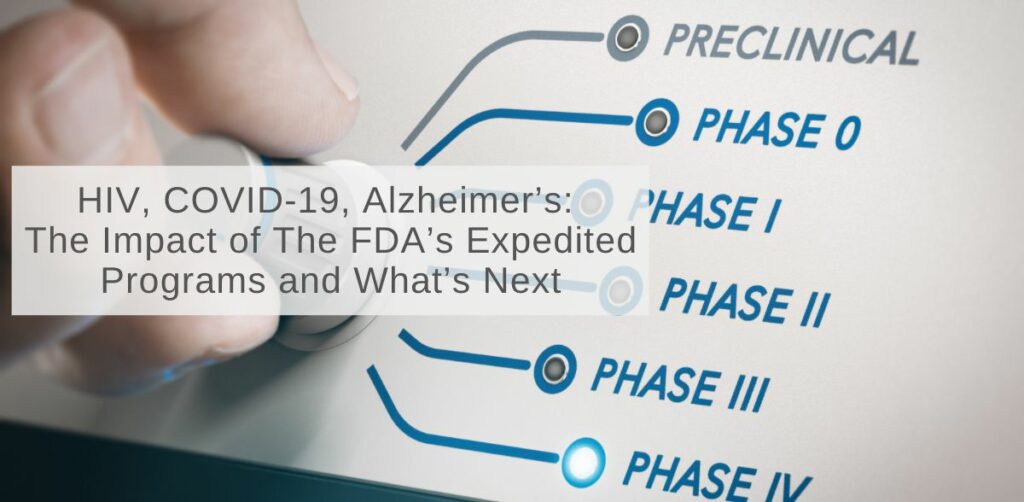Summary
The FDA’s emergency use authorization (EUA) of the COVID-19 vaccines has brought the approval process of vaccines and drugs into public consciousness, however, the FDA’s ability to streamline medical products is not new. For instance, the FDA’s expedited programs have had a profound effect on disease therapies, and clinical researchers have been pushing to expand the accelerated approach, rather than slow it down. This conversation is especially pertinent in light of the FDA’s recent approval of the new Alzheimer’s Drug, Aduhelm, which some are likening to the game changing (and expedited) HIV therapy, didanosine, of the 1990s. In this article we will discuss the history of the drug development pipeline, and ways it can be improved.
The FDA drug approval process has entered everyday conversation thanks to the COVID-19 outbreak. Despite the overwhelming consensus that the COVID-19 vaccinations are safe and effective, they are still not fully approved by the FDA. This is concerning to public officials, who feel that the ’emergency use authorization’ status is a sticking point for people who are on the fence about getting vaccinated (Staahl, 2021). Recently, the Kaiser Family Foundation showed that this concern is warranted – 31% of unvaccinated adults said they would be more likely to get the vaccine if it had full authorization (Addler, 2021).
Jonathan Darrow, an Assistant Professor at Harvard Medical School, has warned that decreasing confidence in the FDA’s approval process could lead to “an erosion of the ‘FDA approved’ brand” (Carroll, 2020). The general public might be wary, but the COVID-19 vaccine isn’t the first medical product to be expedited by the FDA – EUAs were issued during the Zika Virus, H1N1, and Ebola (Lynch, 2021). Many Americans also take daily drugs that were approved this way, whether or not they were previously aware of it, as the FDA’s accelerated approach to drug therapies has been around since the 1980s.
The first law that Congress passed with the goal of making drug development faster was the Orphan Drug Act in 1983 that encouraged drugmakers to develop therapies for rare diseases (Lupkin, 2020). This law allowed for approval with more flexibility, and in doing so, addressed some of the main problems with holding rare disease treatments to the same standards as more widespread treatments – such as having a smaller population pool to draw from.
In the early 1990s, the FDA’s accelerated approval program made a huge impact on the prognosis of HIV by allowing for a surrogate biomarker to be used in HIV treatments (Kakkis, 2021). As a result, effective therapies were rapidly available, and HIV became a controllable disease. Moving into today, comparisons have been drawn between the imperfect accelerated HIV therapies in the 90s, and the recently approved Alzheimer’s drug, Aduhelm (read more about this controversial new drug here). The hope is that what happened with HIV treatments (a surge in investment, and 29 new or improved therapies within 16 years) could happen for Alzheimer’s. Even if Alzheimer’s therapies fall short of this in the coming decades, however, the benefits of the accelerated approval program are apparent. Beyond getting drug therapies from the lab to patients faster, this program could also help reduce drug development costs approximately 60% (Kakkis, 2021).
Proponents of making the expedited pathway more available also argue that the approval process should be reevaluated as emerging tools and technologies have made it possible to establish the safety of therapies faster. For instance, Artificial Intelligence is currently being used in clinical trials, helping to provide, “the intelligence that we, as humans, aren’t able to [obtain] because we can’t crunch that amount of information and come up with a solution” explained Dave Anderson, Marketing VP of Dynatrace (Conklin, 2021). And access to high quality in vivo data can “limit unnecessary research involving human subjects” (Bode, 2020). These new tools are especially important as we enter a post-COVID-19 world, with “such a substantial backlog” in drug applications and inspections that, “it’s likely that it’s going to take a very long time for the FDA to clear that backlog and get back to where they should be” (Bushak, 2021).
From HIV to COVID-19, the FDA’s ability to make life-saving therapies quickly accessible to the general public has been a cause for good. And while the scientific community should continue to provide checks and balances against the administrative body of the FDA, looking forward, these expedited programs could make it possible for products to the market even when faced with the long-term pandemic-induced disruption.
Accelerate your drug discovery and development journey with our comprehensive services. Contact us now to unlock the possibilities and expedite the development of life-changing treatments.
References
- Census Bureau, (2020). Older Americans Month: May 2021. https://www.census.gov/newsroom/stories/older-americans-month.html
- James, Julia (2010). Why drug development is time consuming and expensive (hint: it’s hard). Scope, published by Stanford Medicine. https://scopeblog.stanford.edu/2010/07/21/mochly_rosen_lecture/
- Ogbru, Omudhome (2020). Why Drugs Cost So Much. MedicineNet. https://www.medicinenet.com/drugs_why_drugs_cost_so_much/views.htm
- Peterson, Peter G. (2020). Why are Americans Paying More For Healthcare? https://www.pgpf.org/blog/2020/04/why-are-americans-paying-more-for-healthcare
- Rowe, Sebastian (2020). Modern Drug Discovery: Why is the drug development pipeline full of expensive failures? SITN (Science in the News: a Graduate Student Group at the Harvard Graduate School of the Arts and Sciences). https://sitn.hms.harvard.edu/flash/2020/modern-drug-discovery-why-is-the-drug-development-pipeline-full-of-expensive-failures/#
- Vitale, James (2019). Animal Models in Drug Discovery. Taconic. https://www.taconic.com/taconic-insights/quality/animal-models-drug-discovery.html#footnote
- Wilson-Sanders, S.E. (2011). Invertebrate Models for Biomedical Research, Testing, and Education, ILAR Journal, 52 (2) 126-152, https://doi.org/10.1093/ilar.52.2.126



